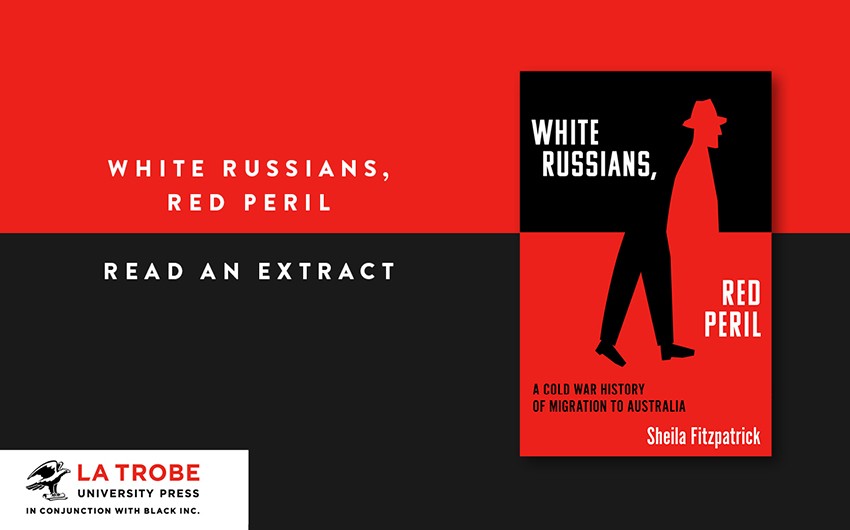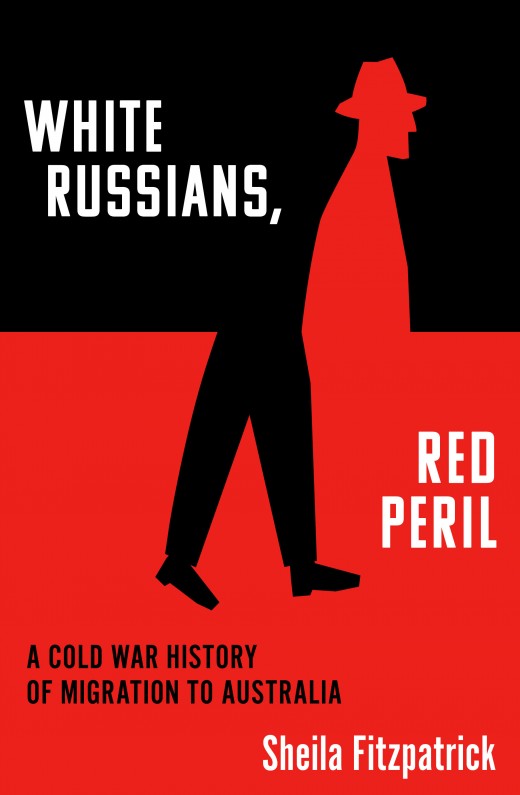News

News >
Read an extract: White Russians, Red Peril
White Russians, Red Peril is a cold war history of migration to Australia.
This is a migration story. Not the benign kind of migration story in which people look to better their situation by moving to a foreign land, but the desperate kind, in which refugees whose lives have been overturned by war and other disasters take a leap into the unknown because some distant country offers them a visa. In this story, the people are Russians who came to Australia after the Second World War. The war was the eruption that uprooted most of them and made them (in the current official lexicon) ‘displaced persons’, or DPs, but the earlier Russian Revolution of 1917 and the Chinese Communist Party’s coming to power in China in 1949 are also part of the story. Some Russian migrants were Soviet citizens up to the outbreak of war and were displaced directly by that war, and some had fled Russia after the revolution and spent the interwar years in Europe or China.
Australia, remarkably, was the country that took in the largest number of Russian displaced persons – stole them, in the Soviet view – until the much larger and more multicultural United States overtook it in a late spurt. Despite that achievement, of which no-one in Australia seems to have been conscious, Russians constituted a relatively small part of Australia’s unprecedentedly large postwar intake of non-British migrants, though substantially larger than the official statistics suggest. A reasonable estimate on the basis of very tricky data would be that about 20,000 Russians arrived from Europe and China in the period 1945–54, with another 5000 coming in from China by 1960 for a total of around 25,000 Russian migrants arriving in the fifteen years after the Second World War.
Whatever the numbers, the Russian contingent is a particularly interesting one. First, their trajectories of displacement before their arrival on Australian shores were fascinatingly complicated and disparate: the most ordinary person was likely to have an extraordinary story to tell if he felt like it (which many did not). Second, they often claimed a nationality other than Russian and kept quiet, because of this deception, about the details of their past. Finally, they arrived in Australia as the Cold War was taking hold, ostensibly firm anti-communists, but nevertheless having the Soviet Union as a not wholly repudiated homeland – a former Second World War ally that had become the Cold War enemy.
Russians have been almost totally invisible in Australia’s postwar migration story. This is partly because their numbers were smaller than the big migration groups of that era – Poles, Yugoslavs, Italians – and partly because of a habit of concealment on the part of those coming from Europe, who had often made themselves invisible by travelling under other national labels and, once arrived, preferred to keep a low profile for fear of trouble with the Soviets or Australian security.
Russians arrived in Australia in the late 1940s and 1950s from two directions: Europe and China. The European stream came mainly from the DP camps of Germany, Austria and Italy, courtesy of the mass resettlement scheme established by the International Refugee Organization (IRO) in 1947 and continuing until 1950–51. The DP camps were set up to look after people who had been displaced by the Second World War – as forced labourers and prisoners of war – and had ended up outside their countries of origin, which were for the most part the Soviet Union (including the Baltic states, incorporated into the USSR in 1939), Poland, Yugoslavia and other countries of Eastern Europe. Prewar Russian émigrés – the so-called ‘first wave’ that had flowed out after the Bolshevik Revolution of 1917, also known as ‘White Russians’ (in contrast to the ‘Reds’) – were not initially covered by the IRO’s mandate, because their displacement preceded the Second World War. But many of them managed to acquire DP status anyway and make their way to Australia, with the rest, on ships chartered by the IRO.
The China stream consisted of White Russians (of many ethnicities) who, at the end of the Russian civil war (circa 1922), had crossed the border and settled in China. They had been there for more than a generation, and many were born there. Harbin, in Manchuria, was a major locus: originally a Russian town, it was established when the Russians were building the Chinese Eastern Railway at the turn of the century. Shanghai, Tianjin, Dalian and other coastal cities of China also acquired large Russian populations, including former officers in the defeated White armies (including Ataman Semenov’s Cossacks). The Manchurian Russians had lived under Japanese occupation from the early 1930s until the end of the war, when the region was briefly under Soviet occupation. The Shanghai contingent had been under a less rigorous form of Japanese rule and for a briefer period, beginning in 1937; in this case it was the Americans who came in as a major postwar presence. It was not war that displaced the ‘China’ Russians for a second time but the increasingly unwelcoming attitude of the Chinese once the Communists took power in 1949.
This migration story is intimately connected with the Cold War, both in the process that brought the migrants to Australia and the official and popular attitudes they encountered when they arrived. The migration dimension is absent from most Cold War histories, which instead tend to focus on high-level diplomacy, the superpowers’ quest for allies and client states, and the fear of spies and enemies within. But in any discussion of the Cold War as an international phenomenon, migration should be an important theme. Migrants were a possible carrier of the communist contagion, particularly if Russian was their native language. Moreover, from the Soviet standpoint, ownership of displaced persons was one of the contentious issues of the early Cold War. The Soviets wanted all their former citizens repatriated; and when the West demurred, and later arranged the resettlement of non-returnees in faraway countries like Australia, the Soviets were full of indignation at the ‘theft’ of ‘their’ people. From the Western standpoint, there was no theft but rather a humanitarian effort on behalf of people who had allegedly ‘chosen freedom’, as a favourite trope of the Cold War would have it, rather than life under communist dictatorship. Failing to recover ‘their’ DPs, the Soviets then turned to efforts to prosecute the ‘war criminals’ among those who had resettled in Australia and other countries outside Europe. Generally, these individuals had not only fought under German command during the Second World War but had also been involved in atrocities against Jews and other civilians in areas of the Soviet Union that came under German occupation. Australia, in line with other countries on the Western side of the Cold War, refused to hand them over.
Social historians, like Cold War historians, have also tended to be uninterested in migration, preferring to study people and societies in situ rather than in transit, but this has changed for the better with the recent scholarly focus on transnational processes. From my standpoint as a social historian, there is nothing more intriguing than to see how individuals adjust and communities self-organise in the process of uprooting themselves, waiting for resettlement and resettling. In the past, I have studied how people in Russia reinvented themselves in the wake of Russian Revolution, doing their best with the materials at hand to construct personae that would help them avoid new dangers and respond to new opportunities. Earlier, I looked at post-revolutionary upward mobility and how the Russian village reorganised itself in the wake of collectivisation at the beginning of the 1930s (and in the process changed what ‘collectivisation’ meant). This is the first time I have looked at people in motion in a transnational context, which involves self-reinvention, social mobility (often downwards for the first generation of migrants, if not their children) and community self-organisation in the context of the new country. The stimulus for this study was my own remigration to Australia, after almost fifty years away, in 2012.
When I left Australia as a postgraduate student in the mid-1960s, migration was an acknowledged aspect of Australian history – how could it be avoided, given that Australian history was understood as the history of white settlement? – but the non-British migrants who started arriving in large numbers after the Second World War were not yet objects of great scholarly interest. That changed during my absence, with the advent of multiculturalism in the 1980s, but the stress was often on the ‘contribution’ to Australian society and culture made by different groups of migrants. Migration is now an increasingly popular topic in Australian history, especially the experience of migrants after they arrive (their housing, jobs, attitudes to Australians and vice versa, degree of assimilation and so on). This book is a bit different. The experience of arriving in a strange land and making those first efforts to find a place within it are at the end of this particular Russian story, not the beginning. My main focus is on the various trajectories that brought Russian migrants to Australia after the Second World War. Like historian Joy Damousi in her work on postwar Greek migrants, I am interested in the baggage that migrants bring with them (though they may seek to forget it) – in particular, their political experience and memory.
The political baggage that postwar Russia migrants brought is interesting and in some ways contradictory. They all came as anti-communists – refusing to repatriate in the European case, removing themselves from an incoming communist government in the China one – and for the ‘White’ émigrés among them, that anti-communism was part of the group’s core identity. But for those who were Soviet citizens before the war, and who were involuntarily uprooted as a result of becoming prisoners of war or forced labourers, it was more complicated. Non-returning Soviet citizens were as vociferous as any in their refusal to repatriate, especially those who were compromised by having served under German command in the Vlasov army, but that may have masked more ambiguous attitudes.
When American scholars conducted a large-scale interview project with DPs in Germany after the war (the Harvard Project on the Soviet Social System), they found their subjects strongly anti-Soviet with regard to politics. But when it came to social institutions, the DPs expressed quite different views. Despite their denunciations of ‘the Soviet system’ as a whole, they generally appreciated the provision of free medical care and education, the latter of which was seen as opening up opportunities for merit-based promotion; they also embraced a number of ‘Soviet’ values, such as equality, the emancipation of women and non-discrimination on the basis of race and nationality, and expressed pride in Soviet economic and military achievements. Assuming that Australia-bound DPs had similar attitudes to the America-bound, they would have shared this duality of attitude. Of course, a Russian migrant was unlikely to start telling his Australian mates about the medical system in the Soviet Union, or his wife to inform a neighbour over the fence about women’s opportunities there: these would belong to the category of things that are known but not spoken. But for a historian, silences can be as interesting as the most eloquent speech.
White Russians, Red Peril is out now.
Share this post
About the author
Sheila Fitzpatrick is a pioneer in the field of Soviet history. She regularly contributes to the London Review of Books and is the multi-award-winning author of many books, including Everyday Stalinism, On Stalin's Team, The Russian Revolution, White Russians, Red Peril and the bestselling The Shortest History of the Soviet Union.
More about Sheila Fitzpatrick




